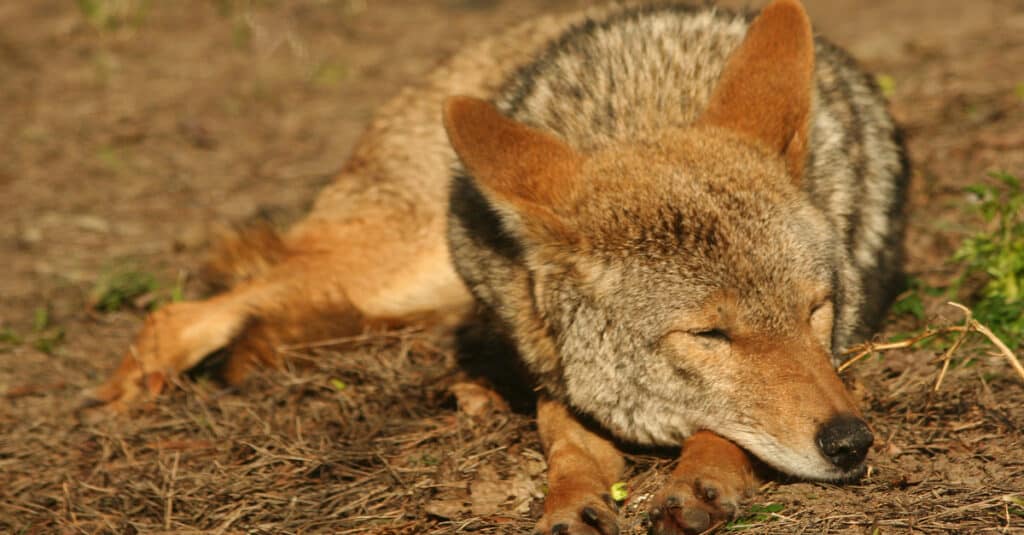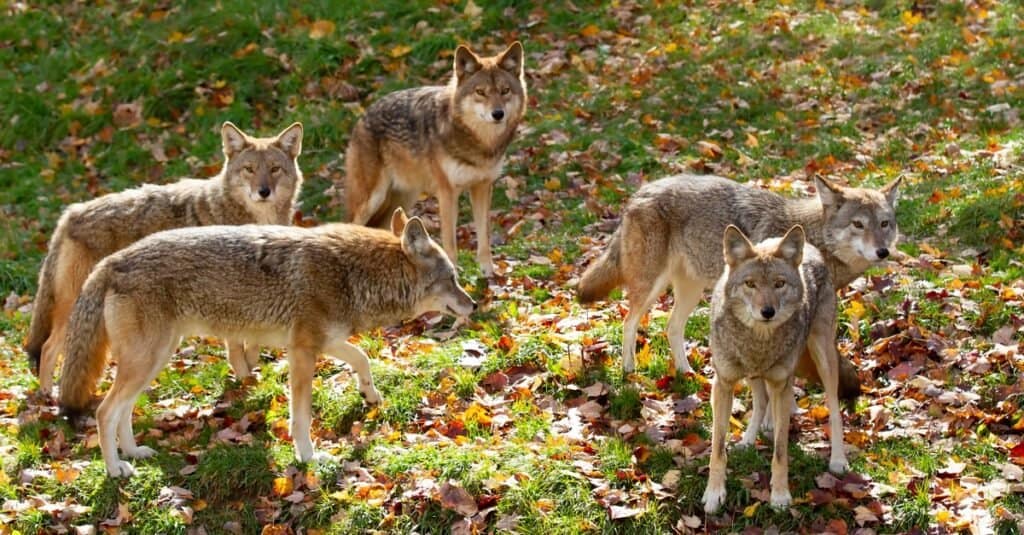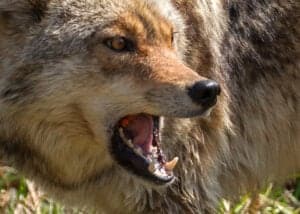Coyotes are native to North America and are known to have a distinct howl, similar to wolves. Many people consider coyotes a danger to their pets and have the misconception that coyotes are nocturnal animals, but this is not the truth. The sleeping pattern and where they sleep depends on their habitat. So are coyotes nocturnal or not? This article explores coyotes’ sleeping behavior and sleeping patterns.
Coyotes may be Diurnal or Nocturnal

Coyotes are naturally diurnal, but their sleep pattern is determined by their habitat
©Mircea Costina/Shutterstock.com
By nature, coyotes are diurnal, but their sleeping pattern or circadian rhythm depends on their environment and location. Coyotes that live near human settlements are nocturnal. This activity pattern is valuable in avoiding contact with humans during the daytime and hunting for food at night. Nighttime is when people hear them howl, causing the misconception that they are nocturnal animals. But coyotes that live further away from humans in more remote areas tend to be diurnal and hunt during the day.
The number of hours coyotes sleep daily varies from a few minutes up to 12 hours. These animals sleep safely in their dens or sleeping areas away from predators. They have varying sleeping patterns and wake up easily if they are disturbed by movement or noises. Coyotes have impressively advanced hearing, making it challenging to sleep uninterrupted for hours.
Coyotes are Active Most at Dusk and Dawn
Because coyotes are naturally diurnal, they are most active during sunrise and sunset. Some may say that this heightened activity at dusk and dawn is crepuscular. Still, the habitat has a powerful influence on the coyote’s behavior. However, they will be inactive during sunrise and sunset if humans are near their dens. Some coyotes have become used to people, and these will likely be diurnal instead of nocturnal.
Coyotes Sleep in Covered Areas

Most coyotes sleep in dens or in areas such as rocky outcrops and hollow trees.
©Liga Alksne/Shutterstock.com
Coyotes commonly sleep in prairies, desert settings, dens in urban areas, and wooded foliage and shrubbery in wild locations. Those coyotes living in urban areas will become nocturnal to avoid human activity when sleeping and most other activities because it is safer. Coyotes often find a place to sleep in parks or golf courses in urban areas. They only sleep where they feel safe and often dig into the ground to build a den for protection while sleeping. You may find coyotes commonly sleeping in:
- Hollow trees. Hollow trees provide a place to rest, hide and look out for predators, threats, and prey.
- Rock outcrops. Rock outcrops offer a view of their surroundings, and coyotes use these spots to locate predators or threats quickly.
- Their dens. These animals are pro-diggers and create holes by digging into the ground. Many coyotes prefer building their shelters as they can make them suit their needs and feel safe.
- In the dens and burrows of other animals. Coyotes are adaptable and may sleep in the dens or burrows of other animals. Sometimes they are fortunate enough to find an abandoned den. At the same time, other coyotes will claim the unoccupied homes of other animals.
Diurnal or Nocturnal – Coyotes do not Hibernate

Coyotes do not hibernate and remain active all through the winter
©Jim Cumming/Shutterstock.com
During the wintertime, coyotes do not hibernate. Coyotes can quickly adapt to many situations, and winter is one of them. Coyotes have winter coats with thick fur. This fur protects them from cold weather and prevents them from freezing during the winter.
Sometimes, coyotes will even sleep in the snow. Male coyotes are known to do this if they cannot find a den or other shelter. Female coyotes do not allow males in their burrows where they keep their pups. If a female has a litter during the winter, she will dig a shelter to protect her pups from the cold and any possible threats.
Some coyotes live in deserts because of the food sources and many spaces for shelter. The moist sand is perfect for building a den, as it is soft to dig into and provides a cool area to escape the heat. Other animals, like badgers and raccoons, also live in desert regions. Coyotes will often steal their dens. If there is shrubbery and foliage nearby, the coyote may sleep under the shade of these plants or on grasses.
Coyotes are Nomadic Animals
Coyotes are nomadic, which means they do not stay in the same area for extended periods. These animals only create dens if they have pups. The coyote remains in the den with her pups until they are old enough to move with them. Coyotes move to different areas to find food and escape predators that have located their den.
They do not only build one den but multiple dens. This industrious behavior allows them to move between living spaces without continuously building a new home for themselves and their pups. Coyotes also build multiple shelters for cleanliness. If one shelter has too many insects or a build-up of droppings, they abandon it as it may cause illness or could contaminate their food.
Coyotes Howl To Communicate

Howling is a common way for coyotes to communicate
©JayPierstorff/Shutterstock.com
Coyotes, like wolves, are known for their howls. Many people are bothered by this behavior because it riles domestic dogs. Coyotes in residential areas also threaten domestic animals as these can become a food source. Besides, hearing coyote howls near residential areas is also unsettling to humans, as wild predators nearby threaten their safety.
Coyotes howl not to disturb dogs and humans but to communicate with each other. Although humans often only hear nocturnal howls, coyotes also howl throughout the day. These wild animals howl to share information with members of their packs and notify others of their presence. Essentially, howling is a form of warning and a territorial technique to claim the region they occupy.
Coyotes are not Nocturnal but they have Night Vision

Coyote have effective night vision which allows them to be such good nocturnal hunters.
©Christopher Bruno / Creative Commons – License
Although these animals are naturally diurnal, they have evolutionary traits that help them alter their sleeping patterns. An example is their ability to see in the dark: night vision. Like dogs and cats, their retinas are almost entirely composed of rods with only a few cones. Rods need less light to activate, and because they have more cones than rods, their night vision is better than their day vision.
Rods have rhodopsin, a photosensitive pigment that is sensitive to low light. During the day, rhodopsin is ineffective as intense light breaks it down. Still, it is created faster during the nighttime in low-light settings. This production means their vision is better at night than during the day.
Coyotes also have tapetum lucidum beneath their retinas. This attribute collects and re-emits light into the retina, which allows the rods to absorb visual information. Consequently, this process produces more effective night vision and makes their eyes glisten at night.
Being a Nocturnal Coyote is an Advantage
Although coyotes are naturally diurnal, adapting to being nocturnal is advantageous when hunting. Coyotes have excellent night vision, which means the effortless location of their prey at night. These animals often eat carrion, relying on their sense of smell to find. But they have the upper hand when hunting for animals like rodents, rabbits, squirrels, and deer.
Many of their target animals do not have good night vision and will likely not see the coyote before it is too late. Coyotes are known to hunt farm animals like chickens and sheep at night. Coyotes target these animals at night when people are sleeping so that they have more privacy and a better chance of making a kill.
Nocturnal vs. Diurnal: What’s The Difference?
Navigate to Nocturnal vs. Diurnal: What’s The Difference? for further information about the nocturnal and diurnal phenomenon in various living creatures.
Up Next – All About Coyotes
- Coyote Dens: Where Do Coyotes Live?
- Coyote Howling: Why Do Coyotes Make Sounds at Night?
- 10 Incredible Coyote Facts
- How and Where Do Coyotes Sleep?
The photo featured at the top of this post is © Mircea Costina/Shutterstock.com
Sources
- , Available here: https://www.hww.ca/assets/pdfs/factsheets/coyote-en.pdf
- A-Z Animals, Available here: https://a-z-animals.com/blog/coyote-dens-where-do-coyotes-live/
Thank you for reading! Have some feedback for us? Contact the AZ Animals editorial team.





